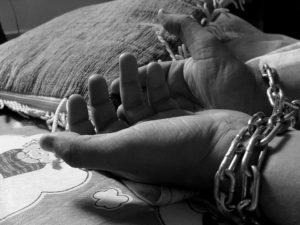 When you search the words “human trafficking” on the internet, hundreds of images of women bound in chains or ropes appear, images like the one shown here. For much of the public, these media-produced images are the only exposure they have to human trafficking. Images like this perpetuate the idea that individuals who are stuck in the world of commercial sexual exploitation are literally and physically bound, kept from leaving by physical restraints. This, for the most part, is untrue. According to the International Labor Organization’s 2016 Report on Modern Slavery, it is estimated that there are about 40.3 million victims of trafficking worldwide, of which about 4.8 million, or roughly 10%, are victims of commercial sexual exploitation. The overwhelming majority of these individuals are not bound by physical ropes and chains but rather by psychological and emotional ones: years of grooming, manipulation, fear, lack of opportunities, and more.
When you search the words “human trafficking” on the internet, hundreds of images of women bound in chains or ropes appear, images like the one shown here. For much of the public, these media-produced images are the only exposure they have to human trafficking. Images like this perpetuate the idea that individuals who are stuck in the world of commercial sexual exploitation are literally and physically bound, kept from leaving by physical restraints. This, for the most part, is untrue. According to the International Labor Organization’s 2016 Report on Modern Slavery, it is estimated that there are about 40.3 million victims of trafficking worldwide, of which about 4.8 million, or roughly 10%, are victims of commercial sexual exploitation. The overwhelming majority of these individuals are not bound by physical ropes and chains but rather by psychological and emotional ones: years of grooming, manipulation, fear, lack of opportunities, and more.
Traffickers also use coercive tactics to make victims believe that they have “no other choice but to continue working for [those pimps]”. Some of the coercion tactics used by traffickers include extreme physical and sexual abuse, providing their victims with illicit substances, and forms of emotional manipulation that include threatening to hurt victims’ families if they run away or refuse to continue selling sex. In addition, traffickers often confiscate their victims’ personal documents, such as identification cards or passports, and convince their victims that they have incurred a debt which must be repaid before they can leave. Moreover, traffickers exploit the fact that victims typically have little education or vocational training by telling them that they have no other option but to work in the commercial sex industry. Traffickers use these tactics to create dependency and maintain control over their victims. No ropes, chains, or physical restraints are needed to bind victims to this life of commercial sexual exploitation. This does not make victims any less stuck, bound, or exploited. Psychological coercion and manipulation can be as strong and binding as any physical restraint.
Perhaps images of bound women and girls are used because it is easier for us to believe that these individuals have no physical opportunity to leave. Perhaps it is easier for us to understand how physical ropes and chains bind people to places and lives that are horrific, rather than to understand how someone can be ‘free’ to walk away but literally cannot because of the strength of the emotional and psychological chains that bind them to the life of commercial sex. However, it is crucial that we understand the truth behind this issue by understanding how individuals enter this life and are coerced to stay. If we understand this truth and overcome the falsehoods portrayed in the images commonly used to illustrate trafficking, we, as a community, will be more equipped and able to help, educate each other, and work towards ending this horrific, exploitative industry.
All views expressed herein are personal to the author and do not necessarily reflect the views of the Villanova University Charles Widger School of Law or of Villanova University.
Lindsay Burrill is a first-year student at the Villanova University Charles Widger School of Law. Lindsay is from Grand Rapids, Michigan. She has a Bachelor’s of Arts degree in Spanish and Clinical Sociology, with an emphasis on Social Justice, from Spring Arbor University. During her time at Spring Arbor, Lindsay worked as the intern for the Spring Arbor University Coalition Against Human Trafficking, where she developed her commitment to addressing the issues of human trafficking and commercial sexual exploitation. During her internship, Lindsay assisted in training counselors and social workers on how to recognize the signs of trafficking and how to treat victims. In addition, she wrote a thesis on human trafficking trends along major highways in Michigan, based on data from “adult” advertisements posted on Backpage.com in 2015 and 2016.



